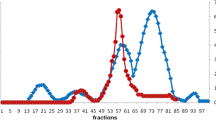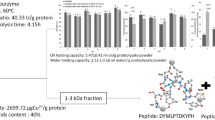Abstract
Calcium-binding peptide was derived from protein hydrolysates. In this study, tilapia protein at a concentration of 2 % (w/v) was hydrolyzed using various proteases including Alcalase 2.4 L, Flavourzyme 1,000L, Protease GN, and papain at 50 °C, pH 8 for 6 h. It was found that the degree of hydrolysis increased with the time of the incubation in all cases. The highest calcium-binding capacity of the hydrolysate was 65 mg/g protein at 27.7 % degree of hydrolysis by Alcalase 2.4 L. The molecular weight of the calcium-binding peptides characterized by gel-filtration chromatography on a Sephadex G-25 was 1.2 kDa. The calcium-binding motif of the hydrolyzed peptides identified by the automated Edman degradation was a short peptide (Trp-Glu-Trp-Leu-His-Tyr-Trp). The results of this study suggested that tilapia protein is a good source for calcium-binding peptides.



Similar content being viewed by others
References
Department of Fisheries Thailand (2011) Strategic development of tilapia (2010–2014) (Online). Available http://www.fisheries.go.th/dof/ (1 September 2011)
Foh MBK, Kamara MT, Amadou I, Foh BM, Wenshui X (2011) Chemical and physicochemical properties of tilapia (Oreochromis niloticus) fish protein hydrolysate and concentrate. Int J Bio Chem 5:21–36
Foh MBK, Amadou I, Foh BM, Kamara MT, Xia W (2010) and antioxidant properties of tilapia (Oreochromis niloticus) as influenced by Functionality the degree of hydrolysis. Int J Mol Sci 11:1851–1869
Raghavan S, Kristinsson HG (2009) ACE-inhibitory activity of tilapia protein hydrolysates. Food Chem 117:582–588
Fitzsimmons K (2004) Development of new products and markets for the global tilapia trade (Online) Available http://ag.arizona.edu/azaqua/ista/ista6/ ista6web/presentation/p624.pdf (1 January 2012)
Daengprok W, Garnjanagoonchorn W, Naivikul O, Pornsinlpatip P, Sigonis K, Mine Y (2003) Chicken eggshell matrix proteins enhance calcium transport in the human intestinal epithelial cells, Caco-2. J Agric Food Chem 51:6056–6061
Mine Y, Shahidi F (2006) Nutraceutical proteins and peptides in health and disease. CRP press, New York
Tunick MH (1987) Calcium in dairy products. J Dairy Sci 70:2429–2438
Bronner F, Pansu D (1998) Nutrition Aspects of Calcium Absorption. J Nutr 129:9–12
Stevenson MD, Brazier JE, Calvert NW, Lloyd-Jones M, Oakley J, Kanis JA (2005) Description of an individual patient methodology for calculating the cost effectiveness of treatments for osteoporosis in women. J Oper Res Soc 56:214–221
Lee SH, Song KB (2009) Isolation of a calcium-binding peptide from enzymatic hydrolyzates of porcine blood plasma protein. J Appl biol chem (Korean Soc Appl Biol Chem) 52:290–294
Coffee CJ, Bradshaw RA (1973) Carp muscle calcium-binding protein I. characterization of the tryptic peptides and the complete amino acid sequence of component B. J Biol Chem 248:3305–3312
Jung WK, Karawita R, Heo SJ, Lee BJ, Kim SK, Jeon YJ (2006) Recovery of a novel Ca-binding peptide from Alaska Pollack (Theragra chalcogramma) backbone by pepsinolytic hydrolysis. Process Biochem 41:2097–2100
Jung WK, Kim SK (2007) Calcium-binding peptide derived from pepsinolytic hydrolysates of hoki (Johnius belengerii) frame. Eur Food Res Tech 224:763–767
Bao XL, Song M, Zhang J, Chen Y, Guo ST (2007) Calcium-binding ability of soy protein hydrolysates. Chin Chem Lett 18:1115–1118
Huang G, Ren L, Jiang J (2011) Purification of a histidine-containing peptide with calcium binding activity from shrimp processing byproducts hydrolysate. Eur Food Res Tech 232:281–287
Adler-Nissen J (1986) Enzymic hydrolysis of food proteins. Elsevier Applied Science Publishers, New York
Whitaker JR, Voragen AGJ, Wong DWS (2003) Handbook of Food Enzymology. Marcel Dekker, Inc. New York
Raghavan S, Kristinsson HG (2008) Antioxidative efficacy of alkali-treated tilapia protein hydrolysates: a comparative study of five enzymes. J Agric Food Chem 56:1434–1441
AOAC (1999) AOAC official methods of analysis 16th ed. Association of Official Agricultural Chemists, Inc. Washington, D.C
Wanasundara PKJPD, Amarowicz R, Pegg RB, Shand PJ (2002) Preparation and characterization of hydrolyzed proteins from defibrinated bovine plasma. J Food Sci 67:623–630
Duncan DB (1995) Multiple range and multiple F tests. Biometrics 11:1–42
Shahidi F (1994) Seafood processing byproducts. In: Shahidi F, Botta JR (eds) Seafoods: chemistry, processing technology and quality, 1st edn. Blackie, London, pp 321–324
Hedstrom L (2002) Serine protease mechanism and specificity. Chem Rev 102:4501–4524
Otto HH, Schirmeister T (1997) Cysteine proteases and their inhibitors. Chem Rev 97:133–171
Lin SJ, Chen LL, Wen CY, Chu WS (2010) Extracellular leucine aminopeptidase produced by Aspergillus oryzae LL1 and LL2. Afr J Microbiol Res 4:158–168
Chabanon G, Chevalot I, Framboisier X, Chenu S, Narc I (2007) Hydrolysis of rapeseed protein isolates: kinetics, characterization and functional properties of hydrolyzates. Process Biochem 42:1419–1428
Gallagher SC, Gao ZH, Li S, Dyer RB, Trewhella J, Klee CB (2001) There is communication between all four Ca2+-bindings sites of calcineurin B. Biochemistry 40:12094–12102
Saguer E, Fort N, Parses D, Toldra M, Carretero C (2007) Improvement of gelling properties of porcine blood plasma using microbial transglutaminase. Food Chem 101:49–56
Zhao X, Chen J, Zhu Q, Du F, Ao Q, Liu J (2011) Surface characterization of 7S and 11S globulin powders from soy protein examined by X-ray photoelectron spectroscopy and scanning electron microscopy. Colloids Surf B Biointerface 86:260–266
Arjmandi BH, Khalil DA, Hollis BW (2002) Soy protein: its effects on intestinal calcium transport, serum vitamin D, and insulin-like growth factor-I in ovariectomized rats. Calcif Tissue Int 70:483–487
Zhou Y, Yang W, Kirberger M, Lee HW, Ayalassomayajula G, Yang JJ (2006) Prediction of EF-Hand calcium-binding proteins and analysis of bacterial EF-Hand proteins. Prot Struct Funct Bioinformatics 65:643–655
Nemirovskiy OV, Gross ML (1998) Determination of calcium binding sites in gas-phase small peptides by tandem mass spectrometry. J Amer Soc Mass Spectrom 9:1020–1028
Kroll RD (1984) Effect of pH on the binding of calcium ions by soybean proteins. Cer Chem 61:490–495
Acknowledgments
This work was financially supported by Office of the Higher Education Commission to Narin Charoenphun under the CHE PhD. Scholarship Program. There was also supported from the Graduate School, Prince of Songkla University.
Author information
Authors and Affiliations
Corresponding author
Rights and permissions
About this article
Cite this article
Charoenphun, N., Cheirsilp, B., Sirinupong, N. et al. Calcium-binding peptides derived from tilapia (Oreochromis niloticus) protein hydrolysate. Eur Food Res Technol 236, 57–63 (2013). https://doi.org/10.1007/s00217-012-1860-2
Received:
Revised:
Accepted:
Published:
Issue Date:
DOI: https://doi.org/10.1007/s00217-012-1860-2




